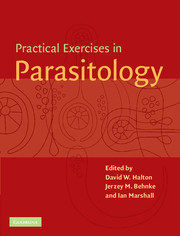Book contents
- Frontmatter
- Contents
- List of contributors
- Preface
- General advice
- 1 Observational Exercises on Parasites
- 2 Ecology
- 3 Physiology and Biochemistry
- 3.1 Hatching in vitro of oncospheres/hexacanth larvae of Hymenolepis diminuta
- 3.2 Activation of the cysticercoids of Hymenolepis species in vitro
- 3.3 Membrane transport in the cestode Hymenolepis diminuta, in vitro
- 3.4 Glycogen utilisation and deposition in flatworm parasites
- 3.5 Effects of classical transmitters on the motility of parasitic roundworms and flatworms
- 3.6 Electrophysiology of Ascaris suum body muscle
- 3.7 Immunocytochemical localisation of neuroactive substances in helminth parasites
- 4 Pathology and Immunology
- 5 Chemotherapy
- 6 Molecular Parasitology
- 7 Behaviour
- Appendix 1 Reagent index
- Appendix 2 UK suppliers
- Appendix 3 US suppliers
- Index
3.7 - Immunocytochemical localisation of neuroactive substances in helminth parasites
Published online by Cambridge University Press: 05 June 2012
- Frontmatter
- Contents
- List of contributors
- Preface
- General advice
- 1 Observational Exercises on Parasites
- 2 Ecology
- 3 Physiology and Biochemistry
- 3.1 Hatching in vitro of oncospheres/hexacanth larvae of Hymenolepis diminuta
- 3.2 Activation of the cysticercoids of Hymenolepis species in vitro
- 3.3 Membrane transport in the cestode Hymenolepis diminuta, in vitro
- 3.4 Glycogen utilisation and deposition in flatworm parasites
- 3.5 Effects of classical transmitters on the motility of parasitic roundworms and flatworms
- 3.6 Electrophysiology of Ascaris suum body muscle
- 3.7 Immunocytochemical localisation of neuroactive substances in helminth parasites
- 4 Pathology and Immunology
- 5 Chemotherapy
- 6 Molecular Parasitology
- 7 Behaviour
- Appendix 1 Reagent index
- Appendix 2 UK suppliers
- Appendix 3 US suppliers
- Index
Summary
Aims and objectives
This exercise is designed to investigate:
The distribution of the biogenic amine, 5-hydroxytryptamine (5-HT), in selected helminths.
The distribution of immunoreactivity to the neuropeptide, FMRFamide, in the nervous system of selected helminths.
Introduction
Immunocytochemistry is a method whereby antibodies, tagged with a visible fluorescent probe or fluorophore, are employed to detect antigens in tissue preparations using a specific antibody- antigen reaction. The most commonly employed immunocytochemical method is the indirect immunofluorescence technique (Coons et al., 1955) in which the primary antibody binds to the antigen in the tissue sample followed by a secondary antibody, labelled with a fluorescent tag, that binds to the primary antibody (Fig. 3.7.1A). The indirect technique allows for more than one secondary antibody to bind to the primary antibody, thereby ensuring amplification of the signal (stronger immunostaining).
The nervous system of helminth parasites is multifunctional and has been shown to be neurochemically complex (Halton & Gustafsson, 1996; Maule et al., 1996). 5-Hydroxytryptamine (5-HT) occurs extensively in the nervous systems of platyhelminth (flatworm) parasites and has been implicated as an excitatory neurotransmitter. FMRFamide is a tetrapeptide amide that was first isolated from the Venus clam, Macrocallista nimbosa, by Price & Greenberg (1977). It is now known that peptides with a similar structure to FMRFamide occur widely throughout invertebrate phyla and are commonly referred to as the FMRFamide-related peptides (FaRPs).
- Type
- Chapter
- Information
- Practical Exercises in Parasitology , pp. 231 - 240Publisher: Cambridge University PressPrint publication year: 2001



